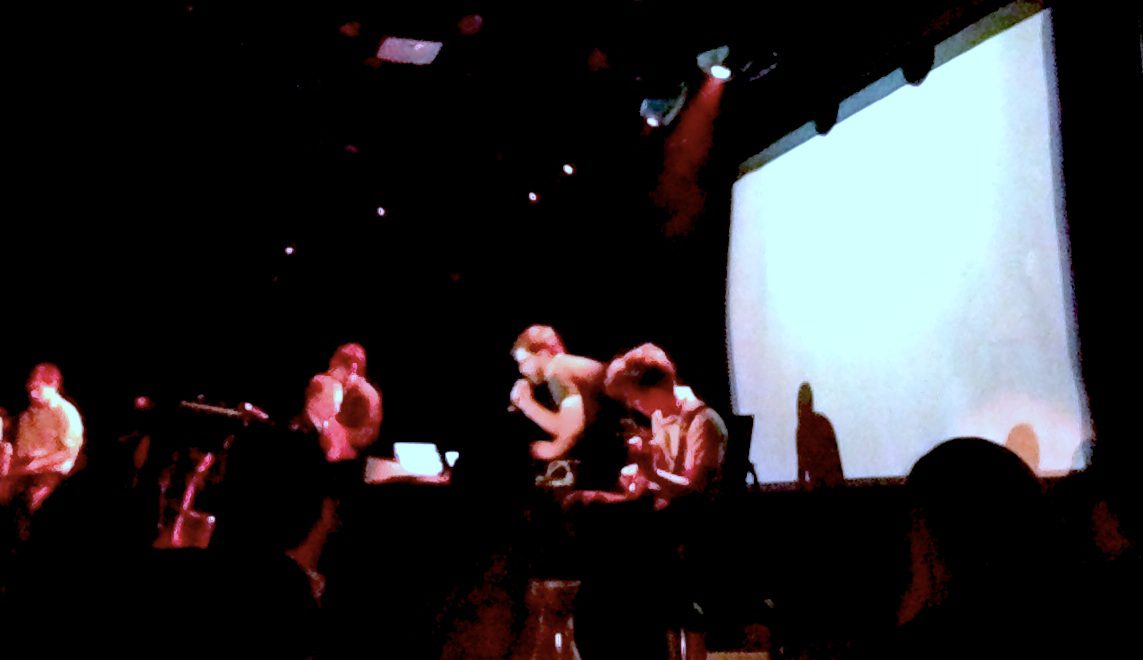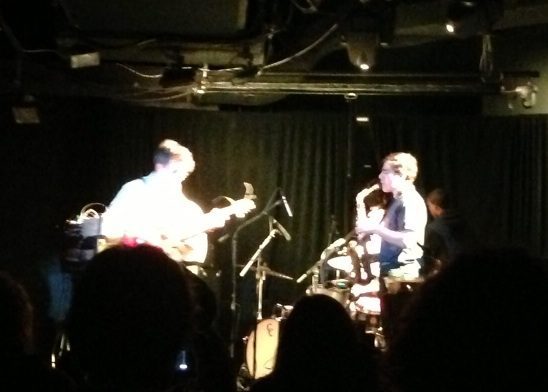
There isn’t really a noise, audible to human ears or otherwise, safe from the all-absorbing sonic stylings of experimental electronic duo Matmos, whose ninth studio LP The Marriage of True Minds is out on Thrill Jockey later this month. On Monday M.C. Schmidt and Daniel Drew dropped into (le) poisson rouge, offering a rather psychedelic testament to their inquisitive and avant-garde creative approach.
[fusion_builder_container hundred_percent=”yes” overflow=”visible”][fusion_builder_row][fusion_builder_column type=”1_1″ background_position=”left top” background_color=”” border_size=”” border_color=”” border_style=”solid” spacing=”yes” background_image=”” background_repeat=”no-repeat” padding=”” margin_top=”0px” margin_bottom=”0px” class=”” id=”” animation_type=”” animation_speed=”0.3″ animation_direction=”left” hide_on_mobile=”no” center_content=”no” min_height=”none”]
It’s hard to define the kind of person who’d be fascinated enough by these processes (not the mention the songs produced by them) to attend their live recreation, though to say fans of Matmos tend to be sort of geeky is probably an obvious start. I never know what to expect in terms of set-up at LPR; the versatile venue sometimes offers seating, sometimes standing only, and the stage migrates throughout the club (my personal favorite set-up being in-the-round). When I bought a ticket at the door seating was offered so I took it, figuring I’d be better able to focus if I wasn’t relegated to a table-less corner where I’d be subject to constant jostling.
Focus proved to be the best asset in truly appreciating the performances that evening, kicked off by Dana Wachs (who performs under the moniker Vorhees). Wachs has been recording as Vorhees since 2005, but her live performances tend to be attached to projects other than her own – she’s soundtracked everything from short films to dance performances at PS122 to fashion shows for Rachel Comey, Imitation of Christ, Y & Kei, Wink, Sebastian Pons and Jess Holzworth. It’s worth mentioning that her resume includes production work for Cat Power, M.I.A. and St. Vincent (among others), though in a way it’s misleading to group her with those artists. The vision she seeks with her explorations in Vorhees is totally separate – a turbulent study in soft electronic loops, her hushed sing-song layered with washes of white noise, droning guitar and loops she creates in front of the audience, rather than relying on a laptop filled with pre-recorded beats. The result is towering but overtakes the listener in subtle builds. As the lone performer on stage, Wachs is a stark but mesmerizing character, releasing bursts of sonance in controlled fashion, giving each element of the track its own time to resonate before adding another airy strata.
[/fusion_builder_column][fusion_builder_column type=”1_1″ background_position=”left top” background_color=”” border_size=”” border_color=”” border_style=”solid” spacing=”yes” background_image=”” background_repeat=”no-repeat” padding=”” margin_top=”0px” margin_bottom=”0px” class=”” id=”” animation_type=”” animation_speed=”0.3″ animation_direction=”left” hide_on_mobile=”no” center_content=”no” min_height=”none”][jwplayer config=”AF01 YT” mediaid=”2287″]

Horse Lords approach from almost the opposite angle, attacking the senses with an onslaught of dense guitar work and pounding polyrhythms delivered by not one but two live drummers, all members of the band performing with scientific focus. That intensity revealed much about the intention behind their work in terms of both composing songs and performing them live; their material hinges on intonation tuning, in which note frequencies relate to mathematical ratios. Even if that concept is a bit over the heads of most casual listeners (mine included) the essence of what it accomplishes is readily apparent. Lead guitarist Owen Gardner actually had to add and painstakingly reposition his frets to accommodate the precise tunings, and the resulting uniqueness of the guitar sound is easy enough to perceive even without calculating algebraic equations. Their work draws on disparate influences, incorporating brass instruments and computers alike. For all of the headiness, though, Horse Lords do not fail to offer something that seems vital rather than removed from itself. If the music itself did not feel so immediate, it would be in danger of becoming obscured by its own elaborate nature. That’s where Horse Lords really get it right – by keeping the music lively they’re free to explore, to take their most intricate concepts to their fullest expression, without losing accessibility.
It’s pretty obvious why a duo like Matmos would be interested in taking Horse Lords under their avant-garde wings (in fact, Horse Lords will continue to open with the band as they embark on a US tour, and Gardner makes a guest appearance on the new record); one can just imagine the hours of music nerd shoptalk going on without end. One can also imagine the collaborative thoughts flying, oddball concepts for albums of the future taking shape, philosophies being debated and debunked, weird noises coming from nowhere or everywhere. It’s easy to imagine because everything Matmos does is based on divine collaboration – with each other, with other musicians, and with objects in the surrounding world. Sometimes that takes the shape of recording an album composed of sounds culled from liposuction surgeries. Sometimes it’s about making a recording in a cow’s uterus and dedicating it to someone who inspired them. And sometimes it means rounding up test subjects, putting them on their backs on a table in a room with with soft red lighting, covering their eyes with two halves of a pingpong ball, and pumping white noise into the headphones they’re wearing while telepathically projecting the concept of the album into the “percipient” brain.
And naturally, that’s exactly what Matmos did, encouraging these newest collaborators to hum or sing whatever sounds or melodies played through their empty, sensory deprived psyches, to describe objects or ideas that did the same. Conceptually, it explores the Ganzfeld effect as much as it attempts to prove or disprove the validity of extra-sensory perception. Sonically, Matmos take a wide berth in interpreting the data they collected and translating it to music. The most obvious difference from their previous work is the appearance of predominant vocals from a slew of guest artists (Dan Deacon, Angel Deradoorian, Jen Wasner to name a fraction) as well as from the members of Matmos themselves, harmonizing on record for the first time in their twenty-year career. But all the quirky sound collage Matmos is known for provides the backdrop – amplified rubber bands as bass lines, sloshing water, sirens, bells, and telephones, tap dancers dancing across a concrete floor. The shuffle of these myriad textures creates a ceaseless movement that makes it easy to forget it was conceived using sensory deprivation. “Teen Paranormal Romance” is ecstatic and burbling and awkward, less like the Twilight saga and more like the aural equivalent of two adolescent spectres fumbling in the dark. “Tunnel” drops out at its most frenzied moment to a creepy whispering, then speeds off again into some mysterious light, all ragged guitars and pitch-shifted synths. The album closes with a schizophrenic cover of The Buzzcocks’ “ESP” and the words “So… think”; the vinyl version has a locked groove of white noise to allow its listeners time to do just that and see what visions come along.
In a live setting, Matmos couldn’t possibly go to all the trouble of recreating the experiment, and if any ticket-holders had been asked to listen to nothing and just envision a Matmos concert, a good portion might have asked for the money back. Instead they opened with an expansive, lysergic iteration of “Very Large Green Triangles” replete with incantatory instructions on how to meditate. There were, of course, hallucinatory projections flickering across the screen behind the musicians, containing visions of, yes, green triangles. There were also mystical hand gestures. This went on for roughly thirteen blissed minutes during which I was exceedingly grateful to be sitting in a chair.
[jwplayer config=”AF01 YT” mediaid=”2286″]
The rest of the set was truly a retrospective of some of the band’s most playful moments, including material that went as far back as 1998’s Quasi-Objects, during which Schmidt blew up a pink balloon and manipulated its surface and the air within it matter-of-factly, as though it were a more conventional instrument. A song from 2001’s A Chance to Cut Is a Chance to Cure featured some queasiness-inducing projections of someone’s insides, yet somehow retained a potent danceability. Despite the fact that Matmos have made a name for themselves as diligent sound collectors as much as musicians, they don’t take themselves too seriously. It was delightful to witness such creative music-making, and easy to laugh along with with their stage banter. One particularly tender moment came when Schmidt realized he was missing an adapter; Drew produced one from his pocket, and Schmidt quipped that it was a dream come true to have a boyfriend who kept such necessities so handy. Up to that point, I’d never considered that the two were a couple, but now it’s easy to see them as insatiable cohorts, conspiring to dream up their lofty album concepts and outlandish recording techniques, and working fearlessly together to share those visions with the world. In that way, The Marriage of True Minds could double as a title for the group’s autobiography as well as its latest record, their perfect synergy and avid curiosity being the impetus for their ground-breaking, genre-defying output.[/fusion_builder_column][/fusion_builder_row][/fusion_builder_container]

